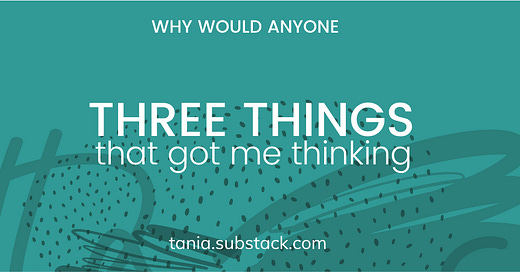#37: Three belated Things that got me thinking
(Not) writing about war + couples' decisions + maths machines
Dear reader,
As you might have noticed, I’m sending these Three motivation-related Things on Thursday instead of Tuesday. That’s because 3.5 people in our family of 5 got sick (as in, hunched-all-night-over-a-bucket sick), and we needed a break. So there will only be this one post this week, and I’ll return 🤞🏾to my normal Tuesday + Friday schedule next week.
Thank you for your patience, and let’s get started.
1. Honesty and tone-deafness
In the first draft of this post, I had included a few paragraphs about the war in Ukraine. I did find a tenuous link to intrinsic motivation, but they weren’t very good paragraphs. So I asked myself: Why am I writing this? Who is it for?
The answer was: because I felt I had to. I wasn’t adding deep insight or honest feelings to the deluge of news and analysis on your timelines; I just didn’t want to seem oblivious.
This post (and some time to think in between vomitus clean-ups) gave me the validation and permission that I needed to press delete:
Having said that, you could:
Read Garrett Bucks’s helpful bullet points about war and what to do about it (H/T Sarah Wheeler):
“The best way to support those who reach out to their neighbors and plead for justice in another part of the world is to build those bonds now with your own neighbors.”
Subscribe to my friend Anita Makri’s thoughtful Worldwise newsletter. Her Ukraine news round-up is free to read. The rest of the post is behind a paywall, but Anita’s offering Why Would Anyone readers a free 30-day subscription here. Her careful curation and global perspective are worth every penny in our times of content overload.
Look at portraits of Ukrainian people, reposted by photographer Brandon Stanton from his Humans of New York 2014 archive.
2. Figuring it out together
I’ve read Couples That Work by Jennifer Petriglieri—for the third time. I keep recognising us in many passages, and recommend this book to everyone who navigates transitions as (part of) a dual-career couple. Or any committed couple, really.
We often think we make joint decisions, Petriglieri warns, but actually talk about surface logistics, rather than about the distribution of power in the couple and what we really want—as individuals, as a pair, as a family. So we fall into patterns (with, say, one primary career and one primary caregiver, if you have children) without really meaning to, or for the wrong reasons; or we stick to existing patterns or personae that doesn’t serve us anymore.
“Many of the people I spoke to had devised intricate ways to synch their calendars, divide up household responsibilities, and balance their careers. Yet they rarely had a conversation about deeper psychological and social forces, by which I mean their struggles for power and control, the roles they expected each other to play in their shared lives, their personal hopes and fears, and the collective expectations of what defines a good relationship and career that exert a powerful influence on them.”
“Tensions almost always stem from a lack of clarity, rather than a lack of equity.”
“Without forethought, identity implications only become apparent a few years after you have made your choices. Many people I interviewed for this book described waking up one morning with the sudden realization that they were living a life they had never anticipated and had become a person they didn’t want to be—that their decisions had made them, instead of them making decisions.”
The remedy, in a nutshell, is to talk to each other—for real though, and often. In the book, Petriglieri offers advice on how to have fruitful conversations, and what traps to avoid.
She also writes at length about navigating mid-life crises together (what she calls “reciprocal individuation”):
“Prior to our forties, whether we like to admit it or not, most of us follow a career of life path molded by social forces that take the shape of parents, friends, and peers at work.”
“For some people, this new way of being will lead to a new way of doing—a new career; a new interest; for some, even a new partner—but inner change must drive the other one, lest the latter become a dramatic way to avoid the former.”
“Because this transition is about tackling the division of roles established [earlier], it is not enough to ask, “What do I really want?” Your story is so intertwined with that of your partner that you must ask, ‘What do we really want?’”
3. Maths robots
This opinion piece by Chinese A.I. researcher Tang Lu draws a convincing parallel between machine learning algorithms and rewards-based methods to teach maths in China:
“China’s success at the [International Maths Olympiads] over the past three decades has not translated into theoretical breakthroughs. Many participants are more focused on the external motivation of winning the prize — admission into a top school — than the joy of mathematics, and only a fraction have any interest in building a career in the field.”
“If there’s an irony here, it’s that, as AI researchers become increasingly adept at finding ways to mimic intrinsic motivation in their algorithms, our schools seem content to turn students into machines.”










Wow, I need to read Couples That Work. It sounds fascinating (and helpful).
Great post as usual, Tania!.
I will be putting that book on my TBR. Thanks for the recommendation Tania.
The insight in the math education is interesting. I just had all my kids parent teacher conferences and I have a math lover in my 10 year. The teacher said he actually try’s to hype the other kids up for math class. So he is intrinsically motivated in that area.